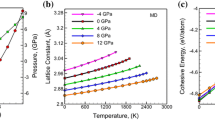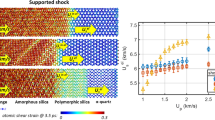Abstract
An important mechanism of detonation initiation in shock compressed energetic molecular crystals is plastic strain localization producing nanoscale shear bands having a pattern that is strikingly similar across a number of crystals of different symmetries. Particle-based coarse-graining emerges as an uncontested approach to model such phenomena, but requires the development of coarse-grain (CG) force fields for molecular crystals. In this paper, we continue our work on the particle-based MSCG/FM (multiscale coarse-graining through force-matching) modeling of hexahydro-1,3,5-trinitro-s-triazine (RDX) [S. Izvekov and B. M. Rice, J. Chem. Phys. 155: 064503 (2021)], where we reported a one-site density-dependent CG force field for the α-RDX crystal. Perhaps the most distinct feature of that force field, referred to as the True-Crystal density-dependent (RDX-TC-DD) model, is its ability to predict the structure of α-RDX. We present the method to extend existing density-dependent CG force fields to what we term energy-conserving variants, which are conservative force fields with explicitly computable potential energy functions, and apply the method to obtain the RDX-TC-DDE model, an energy-conserving extension of the RDX-TC-DD force field. We then apply the isoenergetic dissipative particle dynamics (DPD-E) method using the RDX-TC-DDE force field to study the response of α-RDX to shock compression, demonstrating nucleation of nanoscale shear bands associated with the elastic–plastic transition. The RDX-TC-DDE model and overall workflow open up possibilities to perform high quality simulation studies of shocked molecular energetic materials.
Graphical abstract










Similar content being viewed by others
References
Field JE (1992) Hot-spot ignition mechanisms for explosives, accounts Chem. Res 25:489–496. https://doi.org/10.1021/ar00023a002
Holian BL, Lomdahl PS (1998) Plasticity induced by shock waves in nonequilibrium molecular-dynamics simulations. Science 280:2085–2088. https://doi.org/10.1126/science.280.5372.2085
Jaramillo E, Sewell TD, Strachan A (2007) Atomic-level view of inelastic deformation in a shock loaded molecular crystal. Phys Rev B 76:064112. https://doi.org/10.1103/PhysRevB.76.064112
Rimoli JJ, Gurses E, Ortiz M (2010) Shock-induced subgrain microstructures as possible homogenous sources of hot spots and initiation sites in energetic polycrystals. Phys Rev B 81:014112. https://doi.org/10.1103/PhysRevB.81.014112
Winter RE, Field JE (1975) Role of localized plastic-flow in impact initiation of explosives. Proc R Soc Lond A-Math Phys Sci 343:399–413. https://doi.org/10.1098/rspa.1975.0074
Dodd B, Bai Y (2012) Adiabatic shear localization: frontiers and advances. Elsevier Science Ltd, London
Cawkwell MJ, Sewell TD, Zheng LQ, Thompson DL (2008) Shock-induced shear bands in an energetic molecular crystal: application of shock-front absorbing boundary conditions to molecular dynamics simulations. Phys Rev B 78:014107. https://doi.org/10.1103/PhysRevB.78.014107
Bedrov D, Hooper JB, Smith GD, Sewell TD (2009) Shock-induced transformations in crystalline RDX: a uniaxial constant-stress hugoniostat molecular dynamics simulation study. J Chem Phys 131:034712. https://doi.org/10.1063/1.3177350
Austin RA, Barton NR, Reaugh JE, Fried LE (2015) Direct numerical simulation of shear localization and decomposition reactions in shock-loaded HMX crystal. J Appl Phys 117:185902. https://doi.org/10.1063/1.4918538
Kroonblawd MP, Fried LE (2020) High explosive ignition through chemically activated nanoscale shear bands. Phys Rev Lett 124:206002. https://doi.org/10.1103/PhysRevLett.124.206002
Coffey CS, Sharma J (2001) Lattice softening and failure in severely deformed molecular crystals. J Appl Phys 89:4797–4802. https://doi.org/10.1063/1.1358319
Kartha S, Krumhansl JA, Sethna JP, Wickham LK (1995) Disorder-driven pretransitional tweed pattern in martensitic transformations. Phys Rev B 52:803–822. https://doi.org/10.1103/PhysRevB.52.803
Saxena A, Wu Y, Lookman T, Shenoy SR, Bishop AR (1997) Hierarchical pattern formation in elastic materials. Physica A 239:18–34. https://doi.org/10.1016/s0378-4371(96)00469-4
Pal A, Picu CR (2017) Contribution of molecular flexibility to the elastic-plastic properties of molecular crystal alpha-RDX. Model Simul Mater Sci Eng 25:015006. https://doi.org/10.1088/1361-651x/25/1/015006
Voth GA (ed) (2009) Coarse-graining of condensed phase and biomolecular systems. CRC Press, Boca Raton
Espanol P, Warren PB (2017) Perspective: dissipative particle dynamics. J Chem Phys 146:150901. https://doi.org/10.1063/1.4979514
Hoogerbrugge PJ, Koelman J (1992) Simulating microscopic hydrodynamic phenomena with dissipative particle dynamics. Europhys Lett 19:155–160. https://doi.org/10.1209/0295-5075/19/3/001
Groot RD, Warren PB (1997) Dissipative particle dynamics: bridging the gap between atomistic and mesoscopic simulation. J Chem Phys 107:4423–4435. https://doi.org/10.1063/1.474784
Pagonabarraga I, Frenkel D (2001) Dissipative particle dynamics for interacting systems. J Chem Phys 115:5015–5026. https://doi.org/10.1063/1.1396848
Trofimov SY, Nies ELF, Michels MAJ (2002) Thermodynamic consistency in dissipative particle dynamics simulations of strongly nonideal liquids and liquid mixtures. J Chem Phys 117:9383–9394. https://doi.org/10.1063/1.1515774
Merabia S, Pagonabarraga I (2007) Density dependent potentials: structure and thermodynamics. J Chem Phys 127:054903. https://doi.org/10.1063/1.2751496
Ghoufi A, Emile J, Malfreyt P (2013) Recent advances in many body dissipative particles dynamics simulations of liquid-vapor interfaces. Eur Phys J E 36:10. https://doi.org/10.1140/epje/i2013-13010-7
Brennan JK, Lisal M, Moore JD, Izvekov S, Schweigert IV, Larentzos JP (2014) Coarse-grain model simulations of nonequilibrium dynamics in heterogeneous materials. J Phys Chem Lett 5:2144–2149. https://doi.org/10.1021/jz500756s
Avalos JB, Mackie AD (1997) Dissipative particle dynamics with energy conservation. Europhys Lett 40:141–146. https://doi.org/10.1209/epl/i1997-00436-6
Espanol P (1997) Dissipative particle dynamics with energy conservation. Europhys Lett 40:631–636. https://doi.org/10.1209/epl/i1997-00515-8
Lisal M, Brennan JK, Avalos JB (2011) Dissipative particle dynamics at isothermal, isobaric, isoenergetic, and isoenthalpic conditions using Shardlow-like splitting algorithms. J Chem Phys 135:204105. https://doi.org/10.1063/1.3660209
Izvekov S (2019) Microscopic derivation of coarse-grained, energy-conserving generalized Langevin dynamics. J Chem Phys 151:104109. https://doi.org/10.1063/1.5096655
Hijon C, Espanol P, Vanden-Eijnden E, Delgado-Buscalioni R (2010) Mori-Zwanzig formalism as a practical computational tool. Faraday Discuss 144:301–322. https://doi.org/10.1039/b902479b
Izvekov S (2021) Mori-Zwanzig projection operator formalism: particle-based coarse-grained dynamics of open classical systems far from equilibrium. Phys Rev E 104:024121. https://doi.org/10.1103/PhysRevE.104.024121
Izvekov S, Parrinello M, Burnham CJ, Voth GA (2004) Effective force fields for condensed phase systems from ab initio molecular dynamics simulation: a new method for force-matching. J Chem Phys 120:10896–10913. https://doi.org/10.1063/1.1739396
Izvekov S, Voth GA (2005) Multiscale coarse graining of liquid-state systems. J Chem Phys 123:134105. https://doi.org/10.1063/1.2038787
Izvekov S, Voth GA (2005) A multiscale coarse-graining method for biomolecular systems. J Phys Chem B 109:2469–2473. https://doi.org/10.1021/jp044629q
Noid WG, Chu JW, Ayton GS et al (2008) The multiscale coarse-graining method. I. a rigorous bridge between atomistic and coarse-grained models. J Chem Phys 128:244114. https://doi.org/10.1063/1.2938860
Noid WG, Liu P, Wang Y et al (2008) The multiscale coarse-graining method. II. numerical implementation for coarse-grained molecular models. J Chem Phys 128:244115. https://doi.org/10.1063/1.2938857
Izvekov S, Chung PW, Rice BM (2011) Particle-based multiscale coarse graining with density-dependent potentials: application to molecular crystals (hexahydro-1,3,5-trinitro-s-triazine). J Chem Phys 135:044112. https://doi.org/10.1063/1.3607603
Noid WG (2013) Perspective: coarse-grained models for biomolecular systems. J Chem Phys 139:090901. https://doi.org/10.1063/1.4818908
Moore JD, Barnes BC, Izvekov S et al (2016) A coarse-grain force field for RDX: density dependent and energy conserving. J Chem Phys 144:104501. https://doi.org/10.1063/1.4942520
Izvekov S, Rice BM (2014) Multi-scale coarse-graining of non-conservative interactions in molecular liquids. J Chem Phys 140:104104. https://doi.org/10.1063/1.4866142
Izvekov S (2017) Mori-Zwanzig theory for dissipative forces in coarse-grained dynamics in the Markov limit. Phys Rev E 95:013303. https://doi.org/10.1103/PhysRevE.95.013303
Izvekov S, Rice BM (2021) Bottom-up coarse-grain modeling of plasticity and nanoscale shear bands in alpha-RDX. J Chem Phys 155:064503. https://doi.org/10.1063/5.0057223
Izvekov S, Chung PW, Rice BM (2010) The multiscale coarse-graining method: assessing its accuracy and introducing density dependent coarse-grain potentials. J Chem Phys 133:064109. https://doi.org/10.1063/1.3464776
Sanyal T, Shell MS (2016) Coarse-grained models using local-density potentials optimized with the relative entropy: application to implicit solvation. J Chem Phys 145:034109. https://doi.org/10.1063/1.4958629
Warren PB (2013) No-go theorem in many-body dissipative particle dynamics. Phys Rev E 87:045303. https://doi.org/10.1103/PhysRevE.87.045303
Warren PB (2003) Vapor-liquid coexistence in many-body dissipative particle dynamics. Phys Rev E 68:066702. https://doi.org/10.1103/PhysRevE.68.066702
Kinjo T, Hyodo S-a (2007) Equation of motion for coarse-grained simulation based on microscopic description. Phys Rev E 75:051109. https://doi.org/10.1103/PhysRevE.75.051109
Izvekov S (2013) Microscopic derivation of particle-based coarse-grained dynamics. J Chem Phys 138:134106. https://doi.org/10.1063/1.4795091
Das A, Andersen HC (2010) The multiscale coarse-graining method. V. isothermal-isobaric ensemble. J Chem Phys 132:164106. https://doi.org/10.1063/1.3394862
Ashurst WT, Hoover WG (1975) Dense-fluid shear viscosity via nonequilibrium molecular-dynamics. Phys Rev A 11:658–678. https://doi.org/10.1103/PhysRevA.11.658
Holian BL, Hoover WG, Moran B, Straub GK (1980) Shock-wave structure via non-equilibrium molecular-dynamics and navier-stokes continuum mechanics. Phys Rev A 22:2798–2808. https://doi.org/10.1103/PhysRevA.22.2798
Lisal M, Larentzos JP, Sellers MS, Schweigert IV, Brennan JK (2019) Dissipative particle dynamics with reactions: application to RDX decomposition. J Chem Phys 151:114112. https://doi.org/10.1063/1.5117904
Choi CS, Prince E (1972) Crystal-structure of cyclotrimethylene-trinitramine, acta crystallogr. Sect B Struct Sci B 28:2857–2862. https://doi.org/10.1107/S0567740872007046
Rice BM, Chabalowski CF (1997) Ab initio and nonlocal density functional study of 1,3,5-trinitro-s-triazine (RDX) conformers. J Phys Chem A 101:8720–8726. https://doi.org/10.1021/jp972062q
Mathew N, Picu RC (2011) Molecular conformational stability in cyclotrimethylene trinitramine crystals. J Chem Phys 135:024510. https://doi.org/10.1063/1.3609769
Smith GD, Bharadwaj RK (1999) Quantum chemistry based force field for simulations of HMX. J Phys Chem B 103:3570–3575. https://doi.org/10.1021/jp984599p
Bedrov D, Ayyagari C, Smith GD, Sewell TD, Menikoff R, Zaug JM (2002) Molecular dynamics simulations of HMX crystal polymorphs using a flexible molecule force field. J Comput-Aided Mater Des 8:77–85
Weingarten NS (2017). In: Ciezak-Jenkins JA (ed) Special report ARL-SR-0368 Army Research Laboratory. APG, MD
Stell G, Hemmer PC (1972) Phase-transitions due to softness of potential core. J Chem Phys 56:4274. https://doi.org/10.1063/1.1677857
Hemmer PC, Velasco E, Mederos L, Navascues G, Stell G (2001) Solid-solid transitions induced by repulsive interactions. J Chem Phys 114:2268–2275. https://doi.org/10.1063/1.1321040
Junghans C, Praprotnik M, Kremer K (2008) Transport properties controlled by a thermostat: an extended dissipative particle dynamics thermostat. Soft Matter 4:156–161. https://doi.org/10.1039/b713568h
Smith W, Forester TR (1996) DL_POLY_2.0: a general-purpose parallel molecular dynamics simulation package. J Mol Graph 14:136–141. https://doi.org/10.1016/S0263-7855(96)00043-4
Plimpton S (1995) Fast parallel algorithms for short-range molecular-dynamics. J Comput Phys 117:1–19. https://doi.org/10.1006/jcph.1995.1039
Larentzos JP, Brennan JK, Moore JD, Lisal M, Mattson WD (2014) Parallel implementation of isothermal and isoenergetic dissipative particle dynamics using shardlow-like splitting algorithms. Comput Phys Commun 185:1987–1998. https://doi.org/10.1016/j.cpc.2014.03.029
Melchionna S, Ciccotti G, Holian BL (1993) Hoover NPT dynamics for systems varying in shape and size. Mol Phys 78:533–544. https://doi.org/10.1080/00268979300100371
Khan M, Picu CR (2020) Shear localization in molecular crystal cyclotetramethylene-tetranitramine (β-HMX): constitutive behavior of the shear band. J Appl Phys 128:105902. https://doi.org/10.1063/5.0020561
Parisi G, Procaccia I, Rainone C, Singh M (2017) Shear bands as manifestation of a criticality in yielding amorphous solids. Proc Natl Acad Sci U S A 114:5577–5582. https://doi.org/10.1073/pnas.1700075114
Cawkwell MJ, Ramos KJ, Hooks DE, Sewell TD (2010) Homogeneous dislocation nucleation in cyclotrimethylene trinitramine under shock loading. J Appl Phys 107:063512. https://doi.org/10.1063/1.3305630
Acknowledgements
The authors wish to thank Dr. Brian C. Barnes of the U.S. Army DEVCOM Army Research Laboratory for helpful comments. This work was supported in part by high-performance computer time and resources from the DoD High Performance Computing Modernization Program.
Author information
Authors and Affiliations
Corresponding author
Ethics declarations
Conflicts of interest
The authors have no conflicts of interest to declare.
Additional information
Handling Editor: M. Grant Norton.
Publisher's Note
Springer Nature remains neutral with regard to jurisdictional claims in published maps and institutional affiliations.
Supplementary Information
Below is the link to the electronic supplementary material.
Rights and permissions
About this article
Cite this article
Izvekov, S., Larentzos, J.P., Brennan, J.K. et al. Bottom-up coarse-grain modeling of nanoscale shear bands in shocked α-RDX. J Mater Sci 57, 10627–10648 (2022). https://doi.org/10.1007/s10853-022-07069-z
Received:
Accepted:
Published:
Issue Date:
DOI: https://doi.org/10.1007/s10853-022-07069-z




